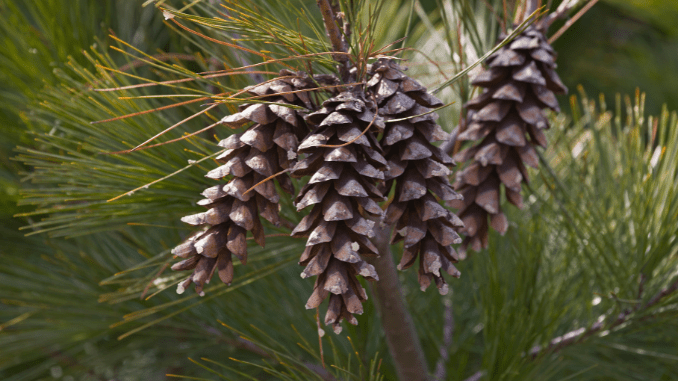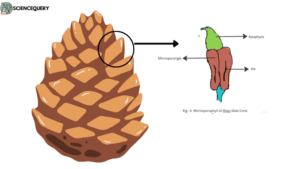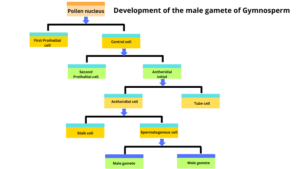
Introduction
The gymnosperm (naked seed-bearing vascular plants) ‘Gymnos’ and ‘Sperma’ in Greek means naked and seed. As the name suggests, the ovules remain exposed, both before and after the completion of fertilization.
Gymnosperms are mostly woody (in some cases shrubby) in nature, having roots, shoots, and leaves. The root system is generally like dicots (tap root type). However, leaves are generally two types; scaly and foliage. Scale leaves of Gymnosperms are brown, thick, and hard. Foliage leaves are green, soft, and needle-like.
Gymnosperms are heterosporous (have two types of spores) with both haploid microspores and megaspores. There are some modified leaves called sporophylls. Sporangia (sacs containing spores) remain attached to sporophylls. The sporophytic phase (asexual phase) is dominant and diploid. The gametophytic phase (sexual phase) is haploid and short-lived.
Importance of understanding the life cycle of gymnosperm
The life cycle of gymnosperms can tell us about
- The structure of both male and female strobili or cones
- Formation of microspores and megaspores
- How spores develop into gametes
- The process of fertilization
- How their life cycle differs from the other seed plants i.e., Angiosperm
Classification of Gymnosperms
There are four major groups of Gymnosperms
- Cycadales
- Coniferales
- Ginkgoales
- Gnetales
Cycadales
The Cycads are evergreen gymnosperms. The dioecious (The male and female organs are in seperate individuals) plants have lateral or terminal cones. Young leaves exhibit circinate vernation (tightly rolled up like a coil ). This group of gymnosperms shows no such significant evolutionary changes. Because of this, Cycads are called “Living Fossils”.
Examples are Cycas, Dioon
Coniferales
Conifers are typically cone-bearing gymnosperms. Monoecious plants bear either male or female cones. The ovules of female cones remain on the ovuliferous scales. Pith (soft spongy tissue) is present in small amounts while vessels are absent. Roots are known as mycorrhizal roots. As roots of this gymnosperm group generally show association with mycorrhiza.
Examples are Pinus, Juniperus
Ginkgoales
Leaves are fan-shaped or strap-shaped with dichotomous venation. Secondary wood is pycnoxylic (compact and less pith). Sperms of these gymnosperms are ciliated (hair-like projection). Ovules are 2-10 in number and present terminally on axillary branches. Seeds exhibit radial symmetry.
Every genus of this gymnosperms group became extinct except Ginkgo biloba. Hence, Ginkgo is called a living fossil. This plant grows in some particular areas in China and Japan.
Examples are Ginkgo biloba
Gnetales
It is the most evolutionary advanced group of gymnosperms. Leaves remain in whorl. The strobili of male and female cones look like the inflorescence of Angiosperms. Perianth (that is envelop) is present in male plants. The embryo is dicotyledonous.
Examples are Gnetum ula
Life Cycle of Gymnosperms
The sporophytic phase is dominant. The life cycle of gymnosperms starts with the formation of male and female strobili or cones. Microspores present in male cones form male gametes. The female gamete is generated from the megaspores of female cones.
The male gametes reach the archegonium (female reproductive organ). After male and female gametes fuse, fertilization occurs. The zygote then results in the embryo.
Male Reproduction of Gymnosperms

Male cones or strobili contain microsporophylls. The pollen grains of gymnosperms remain in the sporangium. Sporangia is present on the lower surface of the microsporophyll. The upper part of the microsporophyll is flattened. This flattened part is called apophysis. Apophysis supplies nutrient to the microsporangia.
Inside the sporangia, numerous pollen grains are there. The nucleus of the pollen grains then undergoes subsequent mitotic divisions to form an antheridial initial. The antheridial initial is the parental cell of male gametes. Antheridial initial gives rise to spermatogenous cells and stalk cells. Male gametes are generated from spermatogenous cells.
Schematic Representation of development of the male gamete of Gymnosperm

Female Reproduction of Gymnosperms
The female cones of gymnosperms bear megasporophylls in clusters. The ovules remain attached to the megasporophylls. In Pinus, we can find two types of scales-(a) Ovuliferous scale and (b)Bract scale.
The ovuliferous scale contains the ovules.
The functional megaspore ultimately gives rise to the female gametophytes in gymnosperm. One of the haploid megaspores works as a megaspore mother cell. Further mitotic divisions result in four megaspores from a single megaspore mother cell. Some nuclei are formed from the megaspore nucleus. Thus, the development of a multicellular female gametophyte is completed.
The female gametophyte contains two to four archegonia. In Gymnosperm, these archegonia are the female sex organs. The archegonium consists of several neck cells and a central cell. The central cell then divides into the ventral canal cell and egg cell. (1)

Pollination in Gymnosperms
Pollination in gymnosperms can occur in several ways. However, one common feature that can be seen in most species is the ovular secretion or pollination drop. Secreted fluid fetches the pollen tube to the ovule. The pollen tube subsequently penetrates the nucellus. Then drops the two male gametes into the embryo sac.
Gymnosperm pollen prefers anemophily or wind pollination. Their low content of water helps them to remain light in weight. Pollination drops or nectar can also cause entomophily. (2)
Fertilization in Gymnosperms
The pollen tube disintegrates the nucellus much like Angiosperms. Enzymes of the egg cell degenerate the neck cells and pollen tube wall. The naked pollen tube drops sperms along with its cytoplasmic content into the embryo sac of the gymnosperm. One of the sperms fuses egg nuclei, and megagametophyte reabsorbs the other one.
Double fertilization is present in Gnetales. Here, two sperms fuse with coenocytic megagametophyte. This results in the formation of two identical diploid zygotes. These are called “Clonal zygotes”. This process of Gymnosperm is much like the double fertilization of Angiosperms.
The zygote forms a proembryo through repeated divisions. Subsequent divisions of proembryo lead to embryo formation. The embryo then develops into the seed. (1)
Seed Dispersal

The Gymnosperm seeds consist of a seedcoat, embryo, and food supply. They often form wings which help in dispersal through the wind. Birds and insects often help to disperse if the seeds are bright in color. Chemical or any other physical stimulation can also help the dormant (inactive) seeds. The seeds do not break their dormancy in unfavorable conditions like extreme cold and minimal light. High temperatures can only help the seed to open its scales and release it into the soil. (3)
Germination and Seedling Development in Gymnosperm
The germination of seeds depends on many factors. Both environmental and internal factors contribute to germination. The epicotyl ruptures the soil surface and the cotyledons go above the ground. The epicotyl does not elongate any further. However, the elongation of hypocotyl goes on and it pushes the cotyledons upward. The germination is epigeal (above the ground) in this case, for example, Pinus.
In Ginkgo, we can see hypogeal (below the ground) germination. After germination, the root and shoot meristem undergo further cell divisions. The shoot is developed from plumule. A seedling is nothing but a young sporophyte that is developed out of the embryo from the seed.
Ecological and Evolutionary Significance of Gymnosperms
Gymnosperms have an essential contribution to economics in today’s world. In paper and furniture production conifers can be used. These are rich sources of ambers and resins. Sago is widely consumed as food. Ginkgo has been considered to have medicinal value since ancient times. It is believed to be useful in memory improvement and better circulation.
As per evolutionary trends, Gymnosperms are the first seed plants. This group of plants is the link between Pteridophytes and Angiosperms. The early Gymnosperms show affinity to Pteridophytes. The advanced ones like Gnetum display characters similar to angiosperms. Thus, it confirms the evolution of angiosperms.
Conservation of Gymnosperms
A large number of gymnosperms have already become extinct. Thus, both in-situ and ex-situ conservation is required. Plants like Ginkgo are being conserved in in-situ (in natural or original condition) conditions. However, their seeds are being kept in seed banks. The cryopreservation method is also being applied along with preserving in Botanical gardens.
Life Cycle Diagram of Gymnosperm

Q&A
1. Are gymnosperms vascular?
Yes, gymnosperms are vascular plants. The xylem vessel is absent, but tracheids are present with sieve cells in the phloem. Albuminous cells take the place of companion cells.
2. How do gymnosperms reproduce?
Reproduction primarily occurs due to the alternation of generation. The dominant sporophyte gives rise to a spore that undergoes mitosis. The gametophytes i.e. pollen and egg cells are formed and fused. The zygote gives rise to the embryo.
3. Do gymnosperms produce seeds?
Yes, gymnosperms produce seeds.
Megasporophylls of the female cones bear the seeds. However, before or after the fertilization, the seed remains naked. The seeds do not get covered by the fruit.
4. When did gymnosperms first appear?
The first gymnosperms or progymnosperms first appeared during the upper Devonian period of the Paleozoic era nearly 380 million years ago. However, during the Mesozoic era, gymnosperms became the dominant. The Jurassic period is considered the ‘age of gymnosperms’ with dominant coniferales.
5. Are gymnosperms vascular or non-vascular?
Gymnosperms are vascular plants. Vascular tissues like tracheids and sieve cells are present along with true stems, leaves and roots.
6. Are gymnosperms sporophyte dominant?
Yes, the sporophytic phase is the dominant phase of gymnosperms.
Gymnosperms’ lifespan mostly consisted of the diploid sporophyte stage. Gametophytic generation is formed due to the meiosis of diploid sporophytes.
7. Are gymnosperms flowering plants?
No, gymnosperms are non-flowering plants.
In any stage of the life cycle, gymnosperms do not bear any kind of flower or fruit. However, in Gnetales, flower-like structures can be seen.
Summary
- Gymnosperms are the non-flowering, naked seed plants where the ovule remains naked before and after fertilization.
- The asexual sporophytic phase is dominant, while the sexual gametophytic phase is recessive. Reproduction takes palace through alternation of generations.
- The plants have vascular bundles but vessels in the xylem and phloem are absent. Vascular bundles are arranged in a ring. Secondary growth occurs.
- Male and female sex organs are in the form of cones. Male and female cone bears microsporophyll and megasporophyll respectively.
- Microsporophyll bears microsporangia. The male gamete is formed from the microspores.
- Megasporophyll contains megasporangium or developing ovules or female gamete. The female gametophyte contains two ovules.
- Double fertilization can be found in Gnetales. However, the process is different than that of angiosperm.
- Pollination primarily occurs through anemophily. Sometimes entomophilic pollination takes place. Ovular secretion of the fluid fetches pollen tube to ovules.
- Seed germination is either epigeal or hypogeal type. Cotyledons are either two or more in number.
- Numerous species of gymnosperms are already extinct. Extant ones are conserved in both in-situ and ex-situ conditions (Germplasm, cryopreservation, seed banks).
References
- https://www.researchgate.net/publication/233530687_Sexual_reproduction_in_gymnosperms_an_overview (1)
- https://www.researchgate.net/publication/329766609_The_Evolution_of_Sexual_Fluids_in_Gymnosperms_From_Pollination_Drops_to_Nectar (2)
- https://www.ck12.org/book/ck-12-biology-advanced-concepts/section/13.42/ (3)
